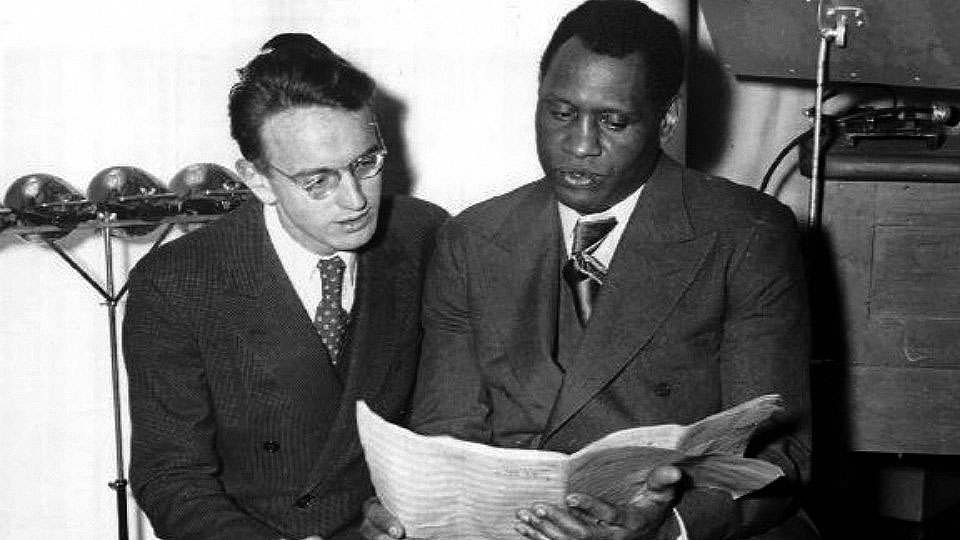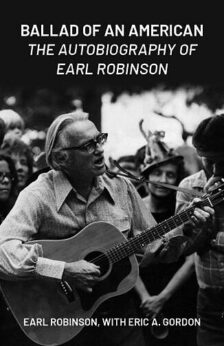
Earl Robinson’s music became a critical part of U.S. working-class culture in the 20th century. Best known for composing the music for songs like “The House I Live In,” “Joe Hill,” and “Black and White,” Robinson wrote many other songs for the stage and movies that will likely be familiar to some readers.
Ballad of an American: The Autobiography of Earl Robinson describes the ups and downs of his collaborations with Abe Meeropol (known by his pen name Lewis Allan and most famous for his lyrics to “Strange Fruit”), Yip Harburg (known for his Academy Award-winning lyrics to “Over the Rainbow”), Paul Robeson and Frank Sinatra (each of whom made “The House I Live In” famous in different ways), Huddie “Leadbelly” Ledbetter, Woody Guthrie, Lee Hayes, Pete Seeger, as well as a host of other performers on behalf of labor unions and left-wing causes. The collaborations were foundational for the “popular front” culture of the mid-20th century and the subsequent folk music roots of popular music.
The close identification of his songs with the Black Freedom struggle caused his enemies in the FBI and on HUAC to misidentify him occasionally as Paul Robeson or as an African-American person. He made this discovery late in life after FOIA access to his FBI record netted more than 1000 pages of documents.
 Robinson died in his hometown of Seattle in 1991, shortly before the collapse of the Soviet Union, with which, despite his critical views, he maintained ties through his music and collaborative spirit. Before his death, he worked with Eric Gordon, now cultural editor at People’s World, to compile and write this memoir. Reprinted now by International Publishers, this accessibly written and compelling personal tale provides insights into the radical working-class circles during the anti-fascist struggle and the later Cold War era from the 1930s through the 1950s and beyond.
Robinson died in his hometown of Seattle in 1991, shortly before the collapse of the Soviet Union, with which, despite his critical views, he maintained ties through his music and collaborative spirit. Before his death, he worked with Eric Gordon, now cultural editor at People’s World, to compile and write this memoir. Reprinted now by International Publishers, this accessibly written and compelling personal tale provides insights into the radical working-class circles during the anti-fascist struggle and the later Cold War era from the 1930s through the 1950s and beyond.
Moreover, it personalizes political struggle, reveals the working life of a talented but occasionally struggling composer, and provides a unique perspective on the transitions many people made from the so-called Old Left to the New Left. Robinson says he left the Communist Party around 1957 but maintained friendships and working partnerships with Party-affiliated cultural workers, labor union leaders, and the socialist countries in Eastern Europe.
In the 1960s, Robinson’s story shifts. Like many people who got into “New Left” culture at the time, Robinson turned from radical and revolutionary systemic critiques of capitalism, white supremacy, and imperialism to self-help gurus, hallucinogenic drugs, psychological therapies, psychic interests, and meditation. In other words, his later life reflects a general inward turn. Still, his continued, determined commitment to peace, anti-racism, and working-class liberation suggests that he closely linked his self-improvement therapies with systemic causes he once foregrounded.
Perhaps for these reasons, the second half of the book, beginning with the chapter devoted to Paul Robeson in the center of the book, is rather different from the first half. Maybe the difference in the content and flow of the story was caused by Robinson’s decision to put distance between himself and the Communist Party, or could be chalked up to the tightening space for his kind of outlook in a more restrictive political climate. I am not sure. The writing focuses on a lot of musical compositions and attempts to regain a professional foothold in the business that had forced him out.
One telling anecdote is his encounter with Supreme Court Justice William O. Douglas in an attempt to get him to hear his music and allow him to write songs about the judge for a planned cantata called Washington Love Story. Robinson sought to remake his artistic success by writing songs about the life of a major progressive historical figure, as he had previously with major compositions on Lincoln and Roosevelt. Douglas and Robinson were natives of the Evergreen State, which the composer thought he could use to gain access. Douglas seems to have been patient when Robinson showed up uninvited to his Washington home while recuperating from a serious illness. But Robinson appears oblivious to how weird the whole episode is.
The book is written plainly and readably. It is full of great stories. His friendly relationship with Eleanor Roosevelt captured in letters and anecdotes about dinner parties and meetings shed light on her wavering politics and activities. His exchange with the HUAC inquisitors reveals a singer-songwriter who fights for the dignity of workers, the right to criticize a corrupt and exploitative system, and still expresses the ordinary fear of power and imprisonment that threatened his livelihood and freedom. His refusal to cooperate earned him years of harassment by FBI goons and right-wing commentators. Under the blacklist he wound up giving guitar lessons (to Arlo Guthrie among others).
I had a lot of fun with this book because I spent some time looking up some of the songs and movies on YouTube. For example, the 10-minute short film, “The House I Live In,” starring Frank Sinatra is there. The story is that Sinatra donated his pay for the film to the California Labor School, which was a Communist-run workers’ school. It was closed down, according to Robinson, because federal tax authorities withdrew its tax-exempt status and billed it for back taxes.
Paul Robeson’s version of that song, which in my opinion is better than Sinatra’s, can also be found on YouTube here. The producers and editors of the original short film with Sinatra excluded the lines of the song that call for racial desegregation in housing (“my neighbors, black and white”), while Robeson never did. The film’s director, the eventually blacklisted Albert Maltz, was angry at the decision. Indeed, some critics of the film argue that the exclusion of this portion of the song’s explicit anti-racist message help to center the story around Euro-American racial solidarity (all the boys in the movie appeared to be Euro-Americans).
I also came across a fun short film titled Muscle Beach, which came out in 1948. Robinson wrote the music (along with lyrics by left-wing poet Edwin Rolfe) and sang the songs. In his brief aside on his work for that short film, Robinson remarks on the intentional irony they built into the film, though he suggests Muscle Beach had little if any political message. The images, the irony of the song’s main message, and its usage of the “talking blues” form hint at a subtle but noteworthy critique of racism and homophobia. A discussion of the original Muscle Beach (on the Pacific Coast at Los Angeles), racial segregation, working-class culture, and the homophobia that targeted beachgoers in the 1950s is beyond the scope of this review, as it was beyond Robinson’s recollection of his work on that film.
This book is a valuable contribution to the story of working-class U.S. culture at one of the peaks of its revolutionary potential.
Ballad of an American: The Autobiography of Earl Robinson
By Earl Robinson with Eric A. Gordon
New York: International Publishers, 2021, 505 pp.
$25.99
ISBN: 9780717808700
Order a copy here from International Publishers.










